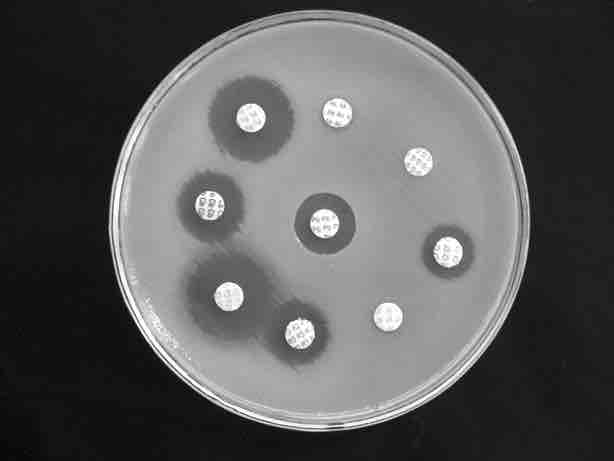Surprisingly, most microbes are not harmful to humans. In fact, they are all around us and even a part of us. However, some microbes are human pathogens; to combat these, we use immunization, antiseptics, and antibiotics.
Immunization is the process by which an individual's immune system becomes fortified against an agent (known as the immunogen) .

Flu Immunization
A naval officer self-administers a nasal spray that immunizes him against the flu.
When the immune system is exposed to molecules that are foreign to the body, it will orchestrate an immune response. It will also develop the ability to respond quickly to subsequent encounters with the same substance, a phenomenon known as immunological memory. Therefore, by exposing a person to an immunogen in a controlled way, the body can learn to protect itself: this is called active immunization.
Vaccines against microorganisms that cause diseases can prepare the body's immune system, thus helping it fight or prevent an infection. The most important elements of the immune system that are improved by immunization are the T cells, the B cells, and the antibodies B cells produce. Memory B cells and memory T cells are responsible for the swift response to a second encounter with a foreign molecule. Through the use of immunizations, some infections and diseases have been almost completely eradicated throughout the United States and the world. For example, polio was eliminated in the U.S. in 1979. Active immunization and vaccination has been named one of the "Ten Great Public Health Achievements in the 20th Century. "
By contrast, in passive immunization, pre-synthesized elements of the immune system are transferred to a human body so it does not need to produce these elements itself. Currently, antibodies can be used for passive immunization. This method of immunization starts to work very quickly; however, it is short-lasting because the antibodies are naturally broken down and will disappear altogether if there are no B cells to produce more of them. Passive immunization occurs physiologically, when antibodies are transferred from mother to fetus during pregnancy, to protect the fetus before and shortly after birth. The antibodies can be produced in animals, called "serum therapy," although there is a high chance of anaphylactic shock because of immunity against animal serum itself. Thus, humanized antibodies produced in vitro by cell culture are used instead if available.
In early inquiries before there was an understanding of microbes, much emphasis was given to the prevention of putrefaction. Procedures were carried out to determine the amount of agent that needed to be added to a given solution in order to prevent the development of pus and putrefaction. However, due to a lack of understanding of germ theory, this method was inaccurate. Today, an antiseptic is judged by its effect on pure cultures of a defined microbe or on their vegetative and spore forms.
Antiseptics are antimicrobial substances that are applied to living tissue to reduce the possibility of infection, sepsis, or putrefaction. Their earliest known systematic use was in the ancient practice of embalming the dead. Antiseptics are generally distinguished from antibiotics by the latter's ability to be transported through the lymphatic system to destroy bacteria within the body, and from disinfectants, which destroy microorganisms found on non-living objects. Some antiseptics are true germicides, capable of destroying microbes (bacteriocidal), while others are bacteriostatic and only prevent or inhibit bacterial growth. Microbicides that destroy virus particles are called viricides or antivirals.
An antibacterial is a compound or substance that kills or slows down the growth of bacteria. The term is often used synonymously with the term antibiotic; today, however, with increased knowledge of the causative agents of various infectious diseases, the term "antibiotic" has come to denote a broader range of antimicrobial compounds, including anti-fungal and other compounds .

Antibiotic Testing
Discs soaked with various compounds are put onto a lawn of bacteria. If the compound on the disc kills or slows bacteria growth, a "halo" of clear media is seen.
The word "antibiotic" was first used in 1942 by Selman Waksman and his collaborators to describe any substance produced by a microorganism that is antagonistic to the growth of other microorganisms in high dilution. This definition excluded substances that kill bacteria but are not produced by microorganisms (such as gastric juices and hydrogen peroxide). It also excluded synthetic antibacterial compounds, such as the sulfonamides. Many antibacterial compounds are relatively small molecules with a molecular weight of less than 2000 amu. With advances in medicinal chemistry, most of today's antibacterials are semisynthetic modifications of various natural compounds.